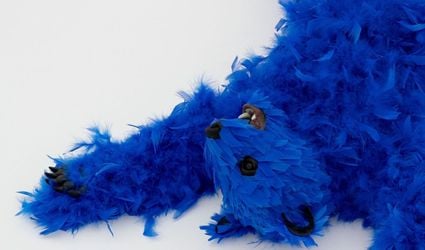Perrotin is delighted to announce an upcoming group exhibition The Blues 2, which will showcase a curated selection of artworks revolving around colour blue from modern and contemporary artists. This exhibition aims to explore the diverse artistic applications employed by individual artists within their distinct styles and seeks to create an ambiance capturing the essence of the summer season. Serving as a thematic continuation of our previous online exhibition,The Blues, the current show further expands the exploration of artworks that utilise the colour blue within the contexts of modern and contemporary art.
'Colour is a natural phenomenon but it is also a complex cultural construct' – Michel Pastoureau1
Over the course of time, the cultural and symbolic perception of the colour blue has undergone constant transformation. In ancient cultures, the scarcity of natural materials resulted in the relative rarity of the color blue. The earliest instances of its usage can be traced back to ancient
Egypt, where it became associated with divinity and transcendence. During the Middle Ages and the Renaissance, the deep blue pigment ultramarine, derived from lapis lazuli, gained prominence in religious art. The challenges encountered in its production contributed to the color's value and elevated status, linking it to religious figures such as the Virgin Mary in Christianity and Lord Krishna in Hinduism, but further on also to the representation of nobility and authority. Renaissance artists such as Giotto, Michelangelo and Titian skillfully explored the luminosity of blue pigments and its spiritual significance in their depictions of the heavens.
In the realm of contemporary culture, the colour blue continues to be a subject of contemplation and inspiration for artists and philosophers. As Johann Wolfgang von Goethe once observed, 'As yellow is always accompanied with light, so it may be said that blue still brings a principle of darkness with it.'2 Blue incites a potent sense of ambiguity; on one hand, it is associated with spirituality and divine subjects, while on the other, it is linked to night, darkness, and melancholy. Thus, for example, in English, the phrase 'feeling blue' literally denotes 'feeling sad.' Yves Klein believed that blue conveyed a sense of tranquility and serenity, capturing the essence of the eternal and immaterial. He argued, 'Blue has no dimensions, it is beyond dimensions.'3
Blue encompasses the vastness of the ocean and the infinite expanse of the sky. It is the colour of nature, representing both the brightness of day and the mystique of a starry night. Blue symbolises the blue dot of Earth against the dark backdrop of the universe, serving as a reminder of the existence of life. The colour blue accumulates a multitude of interpretations and expressions connected to cultural and social aspects, language, aesthetics, and evoked emotions. Philosopher Maurice Merleau-Ponty wrote, '...I am the sky itself as it is drawn together and unified, and as it begins to exist for itself, my consciousness is saturated with this limitless blue,'4 emphasising the embodied nature of perception. Our experience of the colour is not solely based on visual sensation but is also informed by bodily interactions with our surroundings.
Blue 2 presents a curated collection of artworks that explore the symbolic, historical, and emotional dimensions associated with the color blue. In this exhibition for example, the likes of Gerard Schneider, Shim Moon-Seup, Gregor Hildebrandt and Bernard Frize all apply different shades of blue that speak to memories, emotions and thought processes that are not explicitly didactic, rather artworks that the artists have felt comfortable with revealing themselves. On the flip side the gallery presents sharp popping applications of blue that do not harbor self expression, from the likes of Toilet Paper (Maurizio Cattelan and Pierpaolo Ferrari), Paola Pivi, Takashi Murakami, Aya Takano and Daniel Arsham. Rather, these works reveal the commercialised applications of colour and their inevitable need of being eye-catching.
1. P.7
2. 2015. P. 310
3. Philosopher Maurice Merleau-Ponty. Phenomenology of Perception. First published in Routledge Classics 2002 by Routledge. P. 249
4. What was it with Yves Klein and Blue?// https://www.phaidon.com/agenda/art/ar- ticles/2017/april/28/what-was-it-with-yves-klein-and-blue/
Press release courtesy Perrotin.
807, K11 Atelier Victoria Dockside
18 Salisbury Road
Tsim Sha Tsui
Hong Kong
www.perrotin.com
+852 375 821 80
Tuesday – Saturday
11am – 7pm
